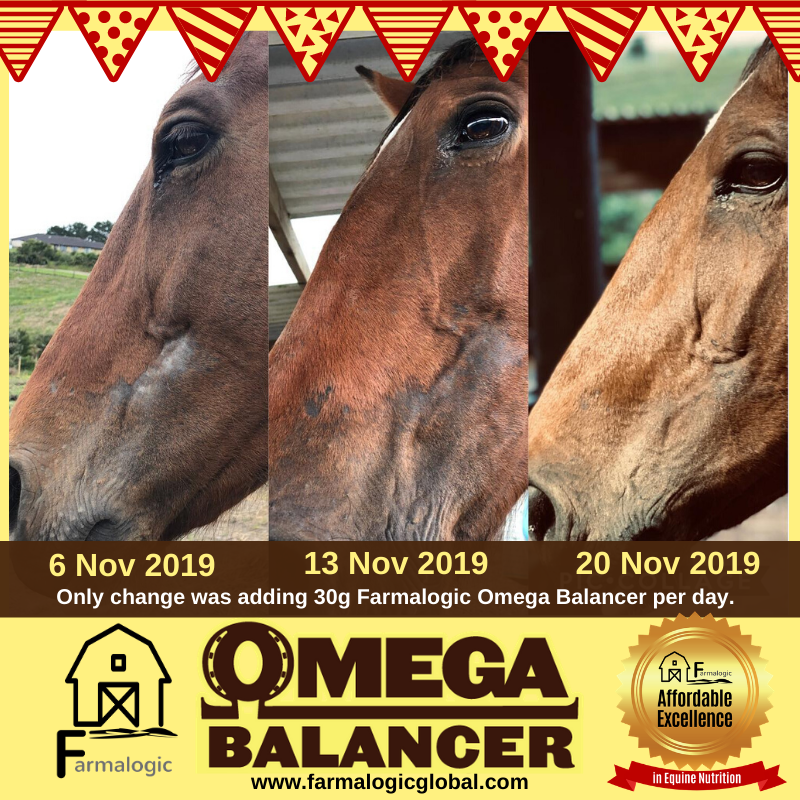There are five elements to consider in managing horses with itchy skin:
- Correct basic nutrition
- Omega-3 to omega-6 balance
- Avoid allergens (often insect bites)
- Topical treatments
- Anti-inflammatory medications.
Itchy horses often have overworked immune systems so correct mineral balance is essential to ensure the immune system has adequate nutrients to function optimally. The diet should also provide more omega-3 fatty acids than omega-6 to modulate the inflammatory processes in the immune system, and to improve the suppleness and strength of cell membranes. This improves the resilience of the skin and reduces dryness.
The Equine Vit&Min range and Farmalogic Omega Balancer are ideal supplements to incorporate into the diets of itchy horses. Consider Farmalogic Melox for additional immune support during acute stages.
Most of the time horses begin to itch due to an immune response to insect bites, although in some cases the trigger could be mycotoxins or contact allergies to pollen, sawdust or other particles in the environment. It is important to try to identify the trigger of your horse’s itch.
Many itchy horses are hypersensitive to the saliva of midges from the species Culicoides. Use rugs to cover sensitive areas such as ears, neck and tail, and regular application of insecticides (permethrin of at least 1% concentration or 10g per litre) and insect repellents such as citronella and neem oil. Many repellents will not work for long enough to be effective between applications.
Try to physically remove your horse from the areas where biting insects like to live. Avoid paddocks with a dam or other sources of standing water. If you stable your horse, use screens and a fan to reduce risk of insect bites. Put your horse in the stable at dusk when biting midges are most active. Consider use of insect baits and attractants to reduce the number of insects in your horse’s environment.
Chronic itch tends to be caused by multiple factors which have an additive affect. The horse will often begin scratching within 15 to 20 minutes after the trigger but sometimes the itching can be a delayed reaction of up to 48 hours later. The process of scratching damages the skin, allowing a secondary bacterial infection to establish, and this keeps the horse itchy. If your itchy horse has flaky skin, it is very likely that there is a bacterial staph infection present.


 Raised lumps as a result of an allergic reaction to insect bites.
Raised lumps as a result of an allergic reaction to insect bites.
Flaking skin usually indicates a bacterial infection.
Sometimes a fungal infection also takes advantage of the broken skin and this can become extremely itchy.
Therefore successful management of chronically itchy horses requires use of an effective anti-bacterial shampoo, spray or lotion and a fungicide if required. Effective active ingredients in topical treatments include chlorhexidine/chlorhexidine gluconate, dichlorophen and benzyl peroxide. Horses have more thinner, less greasy and more sensitive skin than humans so the treatment shampoos designed for horses contain less concentrated active ingredients to avoid irritation.
Troy Hoss Gloss is an example of a medicated antibacterial/antifungal shampoo made for horses. Troy Chloromide is an is an aid in the treatment of topical infections and bacterial skin diseases, wounds, cuts which also contains permethrin insecticide.
Factors to consider when applying creams, lotions or shampoos:
- Shampoo removes oils from the skin so dry skin will become even drier – do not shampoo dry skin with treatment shampoo more than once a week.
- Greasy creams may create a moist environment that encourages bacterial and fungal infections – only use creams which contain an effective anti-bacterial/anti-fungal agent.
- Soothing ingredients such as oatmeal and aloe could be beneficial.
The optimal treatment for your horse could change over time, depending on skin moisture and type and level of infection.
Mycotoxin-associated itch is commonly seen during humid weather and when ryegrass or paspalum grass seed heads are present. If your horse develops itch and signs of photosensitivity (it looks like severe sunburn especially on pink skin) and greasy heel, treatment with a broad-spectrum toxin binder such as Farmalogic Grazaid is recommended along with a zinc and antibiotic cream such as Filtabac.
Horses with severe itch often require intervention with veterinary prescribed corticosteroid creams or injections to help break the itch cycle. Your vet will advise you on appropriate anti-bacterial or anti-fungal treatments to help clear up the skin, and continue with correct nutrition to support the immune system, and management of your horse’s environment to avoid the triggers that caused the initial itch.
TOP TIPS TO MANAGE ITCHY HORSES
- Feed a diet with adequate vitamins and correct mineral balance (Message us for freee advice from our team of qualified Equine Nutritionists. Equine Vit&Min customers are entitled to a free diet analysis).
- Supplement with omega-3 fatty acids, especially in the form of DHA from marine or algal sources – consider Farmalogic Omega Balancer or EVM Omega-3 Plus.
- Prevent insect bites with rugging, screened stables and avoiding paddocks with dams
- Regular application of permethrin insecticides and neem/citronella repellents
- Treat secondary bacterial infections with regular chlorhexidine/chlorhexidine gluconate, dichlorophen and benzyl peroxide creams, sprays, shampoos or lotions such as Troy Hoss Gloss and Troy Chloromide.
- Treat secondary fungal infections if necessary.
- Use an effective toxin binder it itch is associated with mycotoxins in the feed – consider Farmalogic Grazaid along with a zinc and antibiotic cream such as Filtabac.
- Seek veterinary advice if corticosteriod treatment is required to reduce inflammation and break the itch cycle.
With a better understanding of the multiple causes of itch, you will be able to break the itch cycle, manage symptoms and implement management systems to prevent reoccurrence and reduce the risk of your horse’s itch triggers.




